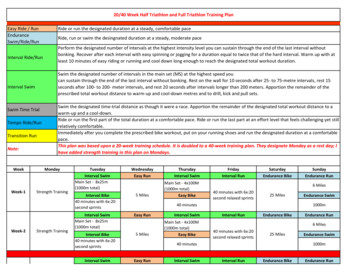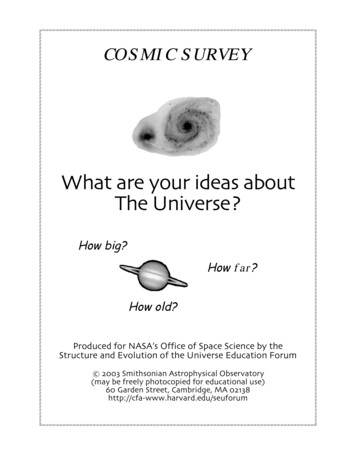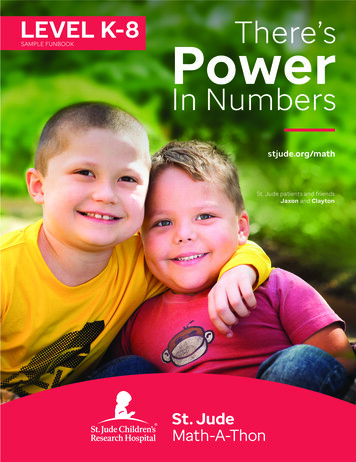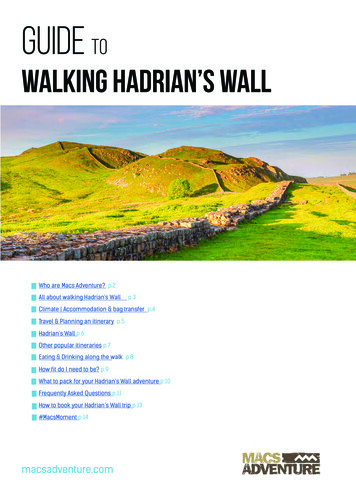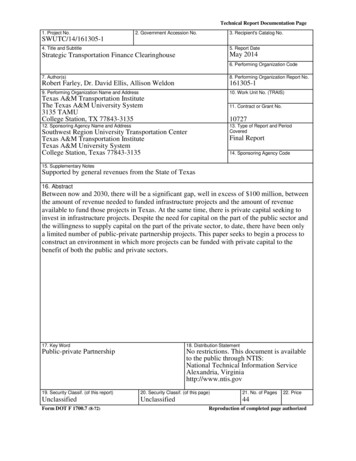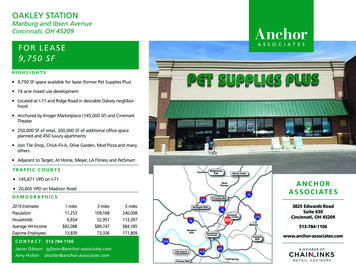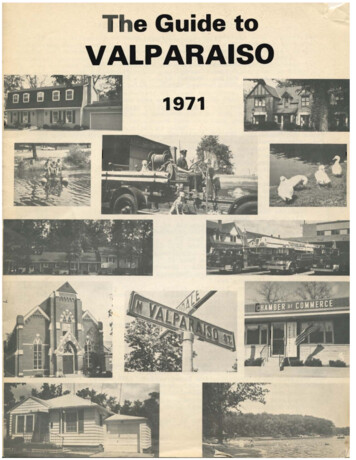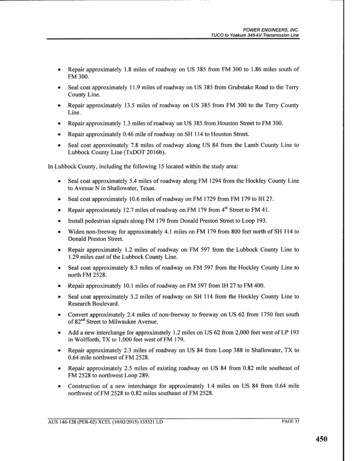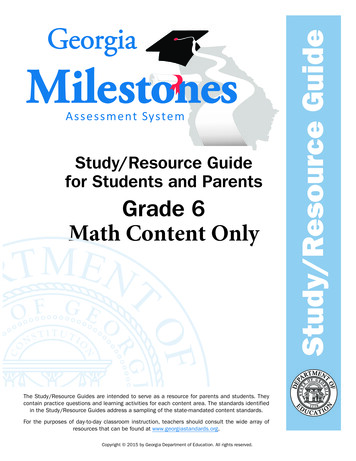
Transcription
MilesstonnesAssessment SystemStudy/Resource Guidefor Students and ParentsGrade 6Math Content OnlyThe Study/Resource Guides are intended to serve as a resource for parents and students. Theycontain practice questions and learning activities for each content area. The standards identifiedin the Study/Resource Guides address a sampling of the state-mandated content standards.For the purposes of day-to-day classroom instruction, teachers should consult the wide array ofresources that can be found at www.georgiastandards.org.Copyright 2015 by Georgia Department of Education. All rights reserved.Study/Resource GuideGeorgrgiaia
Table of ContentsTHE GEORGIA MILESTONES ASSESSMENT SYSTEM . . . . . . . . . . . . . . . . . . . . . . . . . . . . . . . . . . . . . .3HOW TO USE THIS GUIDE . . . . . . . . . . . . . . . . . . . . . . . . . . . . . . . . . . . . . . . . . . . . . . . . . . . . . . . . . .4PREPARING FOR TAKING TESTS . . . . . . . . . . . . . . . . . . . . . . . . . . . . . . . . . . . . . . . . . . . . . . . . . . . . .5OVERVIEW OF THE END-OF-GRADE ASSESSMENT . . . . . . . . . . . . . . . . . . . . . . . . . . . . . . . . . . . . . . . .6TYPES OF ITEMS . . . . . . . . . . . . . . . . . . . . . . . . . . . . . . . . . . . . . . . . . . . . . . . . . . . . . . . . . . . .6DEPTH OF KNOWLEDGE . . . . . . . . . . . . . . . . . . . . . . . . . . . . . . . . . . . . . . . . . . . . . . . . . . . . . . . . . . .7ENGLISH LANGUAGE ARTS (ELA) . . . . . . . . . . . . . . . . . . . . . . . . . . . . . . . . . . . . . . . . . . . . . . . . . . .10DESCRIPTION OF TEST FORMAT AND ORGANIZATION . . . . . . . . . . . . . . . . . . . . . . . . . . . . . . . .10CONTENT. . . . . . . . . . . . . . . . . . . . . . . . . . . . . . . . . . . . . . . . . . . . . . . . . . . . . . . . . . . . . . . . .10ITEM TYPES. . . . . . . . . . . . . . . . . . . . . . . . . . . . . . . . . . . . . . . . . . . . . . . . . . . . . . . . . . . . . . .10ENGLISH LANGUAGE ARTS (ELA) DEPTH OF KNOWLEDGE EXAMPLE ITEMS . . . . . . . . . . . . . . .11ENGLISH LANGUAGE ARTS (ELA) CONTENT DESCRIPTION AND ADDITIONAL SAMPLE ITEMS . . . . .22ENGLISH LANGUAGE ARTS (ELA) ADDITIONAL SAMPLE ITEM KEYS . . . . . . . . . . . . . . . . . . . . .55ENGLISH LANGUAGE ARTS (ELA) SAMPLE SCORING RUBRICS AND EXEMPLAR RESPONSES. . . . .59ENGLISH LANGUAGE ARTS (ELA) WRITING RUBRICS . . . . . . . . . . . . . . . . . . . . . . . . . . . . . . . . .68MATHEMATICS. . . . . . . . . . . . . . . . . . . . . . . . . . . . . . . . . . . . . . . . . . . . . . . . . . . . . . . . . . . . . . . . .77DESCRIPTION OF TEST FORMAT AND ORGANIZATION . . . . . . . . . . . . . . . . . . . . . . . . . . . . . . . .77CONTENT. . . . . . . . . . . . . . . . . . . . . . . . . . . . . . . . . . . . . . . . . . . . . . . . . . . . . . . . . . . . . . . . .77ITEM TYPES . . . . . . . . . . . . . . . . . . . . . . . . . . . . . . . . . . . . . . . . . . . . . . . . . . . . . . . . . . . . . .77MATHEMATICS DEPTH OF KNOWLEDGE EXAMPLE ITEMS . . . . . . . . . . . . . . . . . . . . . . . . . . . . .78MATHEMATICS CONTENT DESCRIPTION AND ADDITIONAL SAMPLE ITEMS. . . . . . . . . . . . . . . . .85MATHEMATICS ADDITIONAL SAMPLE ITEM KEYS . . . . . . . . . . . . . . . . . . . . . . . . . . . . . . . . . . .112MATHEMATICS SAMPLE SCORING RUBRICS AND EXEMPLAR RESPONSES . . . . . . . . . . . . . . . .117SCIENCE . . . . . . . . . . . . . . . . . . . . . . . . . . . . . . . . . . . . . . . . . . . . . . . . . . . . . . . . . . . . . . . . . . . .128DESCRIPTION OF TEST FORMAT AND ORGANIZATION . . . . . . . . . . . . . . . . . . . . . . . . . . . . . . .128CONTENT. . . . . . . . . . . . . . . . . . . . . . . . . . . . . . . . . . . . . . . . . . . . . . . . . . . . . . . . . . . . . . . .128ITEM TYPES. . . . . . . . . . . . . . . . . . . . . . . . . . . . . . . . . . . . . . . . . . . . . . . . . . . . . . . . . . . . . .128SCIENCE DEPTH OF KNOWLEDGE EXAMPLE ITEMS . . . . . . . . . . . . . . . . . . . . . . . . . . . . . . . .129SCIENCE CONTENT DESCRIPTION AND ADDITIONAL SAMPLE ITEMS . . . . . . . . . . . . . . . . . . . . .133SCIENCE ADDITIONAL SAMPLE ITEM KEYS. . . . . . . . . . . . . . . . . . . . . . . . . . . . . . . . . . . . . . .165SOCIAL STUDIES . . . . . . . . . . . . . . . . . . . . . . . . . . . . . . . . . . . . . . . . . . . . . . . . . . . . . . . . . . . . . .178DESCRIPTION OF TEST FORMAT AND ORGANIZATION . . . . . . . . . . . . . . . . . . . . . . . . . . . . . . .178CONTENT. . . . . . . . . . . . . . . . . . . . . . . . . . . . . . . . . . . . . . . . . . . . . . . . . . . . . . . . . . . . . . . .178ITEM TYPES. . . . . . . . . . . . . . . . . . . . . . . . . . . . . . . . . . . . . . . . . . . . . . . . . . . . . . . . . . . . . .178SOCIAL STUDIES DEPTH OF KNOWLEDGE EXAMPLE ITEMS . . . . . . . . . . . . . . . . . . . . . . . . . .179SOCIAL STUDIES CONTENT DESCRIPTION AND ADDITIONAL SAMPLE ITEMS . . . . . . . . . . . . . . .182SOCIAL STUDIES ADDITIONAL SAMPLE ITEM KEYS . . . . . . . . . . . . . . . . . . . . . . . . . . . . . . . . .209APPENDIX A: LANGUAGE PROGRESSIVE SKILLS, BY GRADE . . . . . . . . . . . . . . . . . . . . . . . . . . . . .215APPENDIX B: CONDITION CODES . . . . . . . . . . . . . . . . . . . . . . . . . . . . . . . . . . . . . . . . . . . . . . . . . . . . . 216Copyright 2015 by Georgia Department of Education. All rights reserved.
The Georgia Milestones Assessment SystemTHE GEORGIA MILESTONES ASSESSMENT SYSTEMDear Student,This Georgia Milestones Grade 6 Study/Resource Guide for Studentsand Parents is intended as a resource for parents and students. Itcontains sample questions and helpful activities to give you an idea ofwhat test questions look like on Georgia Milestones and what theGrade 6 End-of-Grade (EOG) assessment covers.These sample questions are fully explained and will tell you why eachanswer is either correct or incorrect.Get ready—open this guide—and get started!Georgia Milestones Grade 6 EOG Study/Resource Guide for Students and ParentsCopyright 2015 by Georgia Department of Education. All rights reserved.Page 3 of 218
How to Use This GuideHOW TO USE THIS GUIDELet’s get started! Get it together! This guide Pen or pencil Highlighter Paper Gather materials Classroom notebooks Textbooks Study space Find a comfortable place to sit. Use good lighting. Time to focus—no TV, games, or phones! Study time Set aside some time after school. Set a goal—how long are you going to study? Remember—you cannot do this all at one time. Study a little at a time, every day. Study buddy Work with a friend, sister, brother, parent—anyone who can help! Ask questions—it is better to ask now and get answers. Make sure you know what you need to do—read the directions beforeyou start. Ask your teacher if you need help. Test-taking help Read each question and all of the answer choices carefully. Be neat—use scratch paper. Check your work!Page 4 of 218Georgia Milestones Grade 6 EOG Study/Resource Guide for Students and ParentsCopyright 2015 by Georgia Department of Education. All rights reserved.
Preparing for Taking TestsPREPARING FOR TAKING TESTSGetting ready!Here are some ideas to think about before you take a test. Get plenty of rest and eat right. Take care of your body and your mindwill do the rest. If you are worried about a test, don’t be. Talk with a teacher, parent,or friend about what is expected of you. Review the things you have learned all year long. Feel good about it. Remember that a test is just one look at what you know. Your class work,projects, and other tests will also show your teachers how much you havelearned throughout the year.Try your best!Georgia Milestones Grade 6 EOG Study/Resource Guide for Students and ParentsCopyright 2015 by Georgia Department of Education. All rights reserved.Page 5 of 218
Overview of the End-of-Grade AssessmentOVERVIEW OF THE END-OF-GRADE ASSESSMENTWhat is on the End-of-Grade Assessment? English Language Arts (ELA)MathematicsScienceSocial StudiesTYPES OF ITEMS Selected-response items—also called multiple-choice English Language Arts (ELA), Mathematics, Science, and Social Studies There is a question, problem, or statement that is followed by four answer choices. There is only ONE right answer, so read EACH answer choice carefully. Start by eliminating the answers that you know are wrong. Then look for the answer that is the BEST choice. Constructed-response items English Language Arts (ELA) and Mathematics only There is a question, problem, or statement but no answer choices. You have to write your answer or work out a problem. Read the question carefully and think about what you are asked to do. In English Language Arts (ELA), go back to the passage to look for detailsand information. You will be scored on accuracy and how well you support your answer with evidence. Extended constructed-response items English Language Arts (ELA) and Mathematics only These are similar to the constructed-response items. Sometimes they have more than one part, or they require a longer answer. Check that you have answered all parts of the question. Extended writing prompt English Language Arts (ELA) only There is a question, problem, or statement. You may be asked to do more than one thing. In English Language Arts (ELA), you will be asked to read two passages andthen write an essay. You will be scored on how well you answer the question and the quality ofyour writing. Organize your ideas clearly. Use correct grammar, punctuation, and spelling. Support your answer with evidence from the text.Page 6 of 218Georgia Milestones Grade 6 EOG Study/Resource Guide for Students and ParentsCopyright 2015 by Georgia Department of Education. All rights reserved.
Depth of KnowledgeDEPTH OF KNOWLEDGETest questions are designed with a Depth of Knowledge (DOK) level in mind. As you gofrom Level 1 to Level 4, the questions get more and more challenging. They take morethinking and reasoning to answer. You may have experienced these types of questionsin your classroom as your teachers find ways to challenge you each day.A Level 1 item may not require as much thinking as a Level 4 item—but that does notmean it’s easy.A Level 4 item may have more than one part or ask you to write something.Here is some information to help you understand just what a DOK level really is.Level 1 (Recall of Information) Identify, list, or define something. Questions may start with who, what, when, and where. Recall facts, terms, or identify information.Level 2 (Basic Reasoning) Think about things—it is more than just remembering something. Describe or explain something. Answer the questions “how” or “why.”Level 3 (Complex Reasoning) Go beyond explaining or describing “how and why.”Explain or justify your answers.Give reasons and evidence for your response.Make connections and explain a concept or a “big idea.”Level 4 (Extended Reasoning) Complex thinking required!Plan, investigate, or apply a deeper understanding.These items will take more time to write.Connect and relate ideas.Show evidence by doing a task, creating a product, or writing a response.Georgia Milestones Grade 6 EOG Study/Resource Guide for Students and ParentsCopyright 2015 by Georgia Department of Education. All rights reserved.Page 7 of 218
Depth of KnowledgeDepth of KnowledgeLevel 1—Recall of InformationLevel 1 asks you to identify, list, or define. You may be asked to recall who, what, when, and where.You may also be asked to recall facts and terms or identify information in documents, quotations,maps, charts, tables, graphs, or illustrations. Items that ask you to “describe” and/or “explain” couldbe Level 1 or Level 2. A Level 1 item requires that you just recall, recite, or repeat information.Skills Demonstrated Make observations Recall information Recognize formulas, properties, patterns,processes Know vocabulary, definitions Know basic concepts Perform one-step processes Translate from one representation to another Identify relationshipsQuestion Cues Tell who, what, when, or whereFindListDefineIdentify; label; nameChoose; selectCompute; estimateExpress asRead from data displaysOrderLevel 2—Basic ReasoningLevel 2 includes some thinking that goes beyond recalling or repeating a response. A Level 2“describe” and/or “explain” item would require that you go beyond a description or explanation ofinformation to describe and/or explain a result or “how” or “why.”Question CuesSkills Demonstrated Apply learned information to abstract andreal-life situations Use methods, concepts, and theories inabstract and real-life situations Perform multi-step processes Solve problems using required skills orknowledge (requires more than habitualresponse) Make a decision about how to proceed Identify and organize components of a whole Extend patterns Identify/describe cause and effect Recognize unstated assumptions; makeinferences Interpret facts Compare or contrast simple concepts/ideasPage 8 of 218 ApplyCalculate; solveCompleteDescribeExplain how; demonstrateConstruct data displaysConstruct; drawAnalyzeExtendConnectClassifyArrangeCompare; contrastGeorgia Milestones Grade 6 EOG Study/Resource Guide for Students and ParentsCopyright 2015 by Georgia Department of Education. All rights reserved.
Depth of KnowledgeLevel 3—Complex ReasoningLevel 3 requires reasoning, using evidence, and thinking on a higher level than Level 1 and Level 2.You will go beyond explaining or describing “how and why” to justifying the “how and why” throughreasons and evidence. Level 3 items often involve making connections across time and place toexplain a concept or a “big idea.”Skills Demonstrated Solve an open-ended problem with more thanone correct answer Create a pattern Generalize from given facts Relate knowledge from several sources Draw conclusions Make predictions Translate knowledge into new contexts Compare and discriminate between ideas Assess value of methods, concepts, theories,processes, and formulas Make choices based on a reasoned argument Verify the value of evidence, information,numbers, and dataQuestion Cues Plan; preparePredictCreate; designAsk “what if?” questionsGeneralizeJustify; explain why; support; convinceAssessRank; gradeTest; judgeRecommendSelectConcludeLevel 4—Extended ReasoningLevel 4 requires the complex reasoning of Level 3 with the addition of planning, investigating,applying deeper understanding, and/or developing that will require a longer period of time. You maybe asked to connect and relate ideas and concepts within the content area or among content areasin order to be at this highest level. The Level 4 items would be a show of evidence—through a task, aproduct, or an extended response—that the higher level demands have been met.Skills Demonstrated Analyze and synthesize information frommultiple sources Examine and explain alternative perspectivesacross a variety of sources Describe and illustrate how common themesare found across texts from different cultures Apply mathematical models to illuminate aproblem or situation Design a mathematical model to inform andsolve a practical or abstract situation Combine and synthesize ideas into newconceptsQuestion Cues DesignConnectSynthesizeApply conceptsCritiqueAnalyzeCreateProveGeorgia Milestones Grade 6 EOG Study/Resource Guide for Students and ParentsCopyright 2015 by Georgia Department of Education. All rights reserved.Page 9 of 218
MathematicsMATHEMATICSDESCRIPTION OF TEST FORMAT AND ORGANIZATIONThe Grade 6 Mathematics EOG assessment consists of a total of 73 items.You will answer a variety of item types on the test. Some of the items are selected-response(multiple-choice), which means you choose the correct answer from four choices. Someitems will ask you to write your response.The test will be given in two sections. You may have up to 85 minutes per section to complete Sections 1 and 2.The test will take about 120 to 170 minutes.CONTENTThe Grade 6 Mathematics EOG assessment will measure the Grade 6 standards thatare described at www.georgiastandards.org.The content of the assessment covers standards that are reported under these domains: Ratios and Proportional RelationshipsThe Number SystemExpressions and EquationsGeometryStatistics and ProbabilityITEM TYPESThe Mathematics portion of the Grade 6 EOG assessment consists of selected-response(multiple-choice) items, constructed-response items, and extended constructedresponse items.Georgia Milestones Grade 6 EOG Study/Resource Guide for Students and ParentsCopyright 2015 by Georgia Department of Education. All rights reserved.Page 77 of 218
MathematicsMATHEMATICS DEPTH OF KNOWLEDGE EXAMPLE ITEMSExample items that represent applicable DOK levels of the Mathematics assessmentare provided for you on the following pages. The items and explanations of what isexpected of you to answer them will help you prepare for the test.All example and sample items contained in this guide are the property of theGeorgia Department of Education.Example Item 1DOK Level 1: This is a DOK level 1 item because it requires students to recallinformation.Mathematics Grade 6 Content Domain: The Number SystemStandard: MGSE 6.NS.5. Understand that positive and negative numbers are usedtogether to describe quantities having opposite directions or values (e.g., temperatureabove/below zero, elevation above/below sea level, credits/debits, positive/negativeelectric charge); use positive and negative numbers to represent quantities in real-worldcontexts, explaining the meaning of 0 in each situation.Which integer represents 10 degrees Fahrenheit below zero?A. 10B.0C. –10D. –20Correct Answer: CExplanation of Correct Answer: The correct answer choice is (C) –10. Temperaturesoften fall below 0. When a temperature is colder than 0 degrees, we use negativeintegers to represent that temperature. Choice (A) is incorrect because it representspositive 10 degrees Fahrenheit, which is 20 degrees warmer than 10 degrees belowzero. Choice (B) is incorrect because it is 10 degrees warmer than 10 degrees belowzero. Choice (D) is incorrect because it represents a temperature that is 10 degreescolder than 10 degrees below zero.Page 78 of 218Georgia Milestones Grade 6 EOG Study/Resource Guide for Students and ParentsCopyright 2015 by Georgia Department of Education. All rights reserved.
MathematicsExample Item 2DOK Level 2: This is a DOK level 2 item that assesses basic reasoning. Studentmust solve a problem using knowledge of adding decimal numbers. Student mustdemonstrate how to solve the problem with valid evidence.Mathematics Grade 6 Content Domain: The Number SystemStandard: MGSE 6.NS.3. Fluently add, subtract, multiply, and divide multi-digitdecimals using the standard algorithm for each operation.Find the sum for this addition problem.6.42 27.58 Show each step you used to find your answer.Georgia Milestones Grade 6 EOG Study/Resource Guide for Students and ParentsCopyright 2015 by Georgia Department of Education. All rights reserved.Page 79 of 218
MathematicsScoring RubricPointsDescription2The response achieves the following: Response demonstrates a complete understanding of how to use a strategy based onplace value to add two decimal numbers. Give 2 points for a correct response and a valid process. Response is correct and complete. Response shows application of a reasonable and relevant strategy. Mathematical ideas are expressed coherently through a clear, complete, logical, andfully developed response using words, calculations, and/or symbols as appropriate.1The response achieves the following: Response demonstrates a partial understanding of how to use a strategy based onplace value to add two decimal numbers. Give 1 point for a correct response that does not include a valid process or contains acalculation mistake made in an otherwise correct process. Response includes the correct sum but no or incomplete explanation. Response shows application of a relevant strategy, though it may be only partiallyapplied or remain unexplained. Mathematical ideas are expressed only partially using words, calculations, and/orsymbols as appropriate.0The response achieves the following: The response demonstrates limited to no understanding of how to use a strategy basedon place value to add two decimal numbers. Response shows no application of a strategy. Mathematical ideas cannot be interpreted or lack sufficient evidence to supporteven a limited understanding.Exemplar ResponsePointsAwardedSample Response34AND6.42 27.58 (6 7 20) (0.4 0.5) (0.02 0.08) (13 20) (0.9) (0.1) 33 1 342OR other valid process134 with no explanation or incomplete work0Response is irrelevant, inappropriate, or not provided.Page 80 of 218Georgia Milestones Grade 6 EOG Study/Resource Guide for Students and ParentsCopyright 2015 by Georgia Department of Education. All rights reserved.
MathematicsExample Item 3DOK Level 3: This is a DOK level 3 item that assesses complex reasoning. The student must evaluateanother student’s work and explain why or why not expressions are equal. The student must changeexpressions to make them equivalent and provide evidence to support his or her reasoning.Mathematics Grade 4 Content Domain: Expressions and EquationsStandard: MGSE 6.EE.4. Identify when two expressions are equivalent (i.e., when the two expressionsname the same number regardless of which value is substituted into them). For example, theexpressions y y y and 3y are equivalent because they name the same number regardless of whichnumber y stands for.Sam wrote these four expressions.1.2.3.4.n n n n 2n n n 24n 22n 2n 2nPart A: Which expressions are equivalent?Part B: Explain your reasoning for Part A.Georgia Milestones Grade 6 EOG Study/Resource Guide for Students and ParentsCopyright 2015 by Georgia Department of Education. All rights reserved.Page 81 of 218
MathematicsPart C: Choose two of Sam’s expressions that are not equivalent. Explain how youknow they are not equivalent.Part D: How can you change one of the expressions from Part C to make the twoexpressions equivalent?Page 82 of 218Georgia Milestones Grade 6 EOG Study/Resource Guide for Students and ParentsCopyright 2015 by Georgia Department of Education. All rights reserved.
MathematicsScoring RubricPoints43210DescriptionThe response achieves the following: The response demonstrates a complete understanding of evaluating expressions andidentifying equivalent expressions. Give 4 points for 4 parts answered correctly. Response is correct and complete. Response shows application of a reasonable and relevant strategy. Mathematical ideas are expressed coherently through a clear, complete, logical, and fullydeveloped response using words, calculations, and/or symbols as appropriate.The response achieves the following: The response demonstrates a nearly complete understanding of evaluating expressionsand identifying equivalent expressions. Give 3 points for correct responses for only three of the four parts OR two of the partshave errors or are incomplete. Response is mostly correct but contains either a computation error or an unclear orincomplete explanation. Response shows application of a relevant strategy, though it may be only partiallyapplied or remain unexplained. Mathematical ideas are expressed only partially using words, calculations, and/orsymbols as appropriate.The response achieves the following: The response demonstrates a partial understanding of evaluating expressions andidentifying equivalent expressions. Give 2 points for correct responses for only two of the four parts OR three of the partshave errors or are incomplete. Response is only partially correct. Response shows application of a relevant strategy, though it may be only partiallyapplied or remain unexplained. Mathematical ideas are expressed only partially using words, calculations, and/orsymbols as appropriate.The response achieves the following: The response demonstrates a minimal understanding of evaluating expressions andidentifying equivalent expressions. Give 1 point for correct responses for only one of the four parts OR three of the partshave errors or are incomplete. Response is only partially correct. Response shows incomplete or inaccurate application of a relevant strategy. Mathematical ideas are expressed only partially using words, calculations, and/orsymbols as appropriate.The response achieves the following: The response demonstrates limited to no understanding of evaluating expressions andidentifying equivalent expressions. Response shows no application of a strategy. Mathematical ideas cannot be interpreted or lack sufficient evidence to support even alimited understanding.Georgia Milestones Grade 6 EOG Study/Resource Guide for Students and ParentsCopyright 2015 by Georgia Department of Education. All rights reserved.Page 83 of 218
MathematicsExemplar ResponsePointsAwardedSample ResponsePart A: Only expressions 1 and 3 are equivalent.ANDPart B: To show that only two of the four expressions are equivalent, I set n equal to 3 ineach expression and evaluated.1.2.3.4.4When n is 3, the expression equals 14.When n is 3, the expression equals 11.When n is 3, the expression equals 14.When n is 3, the expression equals 18.Expressions 1 and 3 are equivalent because when you substitute n for a value, they bothhave the same result. If you substitute the same number for n in the other two expressions,the result is different. This is true for any value of n.OR other valid explanationANDPart C: (answers will vary depending on which expression the student chooses)I chose expressions 2 and 3, which are not equivalent. I know they are not equivalentbecause when I substitute the same value for n in both expressions, they do not equalthe same number.OR other valid explanationANDPart D: If I add one n to expression 2, they are equivalent.3The student correctly answers three out of the four parts.2The student correctly answers two out of the four parts.1The student correctly answers one of the four parts.0Response is irrelevant, inappropriate, or not provided.Page 84 of 218Georgia Milestones Grade 6 EOG Study/Resource Guide for Students and ParentsCopyright 2015 by Georgia Department of Education. All rights reserved.
MathematicsMATHEMATICS CONTENT DESCRIPTION AND ADDITIONALSAMPLE ITEMSIn this section, you will find information about what to study in order to prepare forthe Grade 6 Mathematics EOG assessmentt. This includes key terms and importantvocabulary words. This section also contains practice questions, with an explanation ofthe correct answers, and activities that you can do on your own or with your classmatesor family to prepare for the test.All example and sample items contained in this guide are the property of theGeorgia Department of Education.CONTENT DESCRIPTION Apply and extend understanding of multiplication and divisionDivide fractions by fractionsCompute fluently with multi-digit numbers and rational numbersFind common factors and multiplesApply and extend understandings of algebraic expressionsReason and solve one-variable equations and inequalitiesAnalyze quantitative relationships between dependent and independent variablesUnderstand ratio, area, surface area, and volumeDevelop understanding of statistical variabilitySummarize and describe distributionsGeorgia Milestones Grade 6 EOG Study/Resource Guide for Students and ParentsCopyright 2015 by Georgia Department of Education. All rights reserved.Page 85 of 218
MathematicsMathematicsFormula SheetYou can find mathematics formula sheets onthe Georgia Milestones webpage sment-System.aspx.Look under “EOG Resources.”Page 86 of 218Georgia Milestones Grade 6 EOG Study/Resource Guide for Students and ParentsCopyright 2015 by Georgia Department of Education. All rights reserved.
MathematicsUnit 1: Number System FluencyIn this unit, you will divide numbers and fractions by fractions and identify reciprocalfractions. You will work with decimals and solve multi-digit division. You will learn aboutfactors and multiples of numbers.KEY TERMSQuotients of fractions: Dividing a number by a fraction is determining how many parts11equal to the fraction are in the number. For example, 4 is asking for how many44parts are in 4, which is 16. This same strategy can be used to divide a fraction by1a fraction. For example, 5 1 is asking for how many parts are in 5 , which is 10.422 4Represent division of fractions using equations and fraction models to solve. (NS.1)Remainder: A part of the dividend that is left over when dividing. The remainder islisted as the amount of the equal part that is left over. For example, in the equation3 11 , there is a remaining number of , which is 1 of an equal part. The quotient of8 482this division equation is 1 1. (NS.1)2Reciprocal: Two numbers that have a product of 1. In fractions, reversing the numeratorand denominator creates a reciprocal fraction, such as 2 3 6. When dividing two3 2 6fractions, it is also possible to multiply by the reciprocal to determine the quotient. Forexample, 5 1 can be solved using 5 4 20. (NS.1)2 42 12Standard algorithm: A method used to solve a problem that includes a set of specificsteps. (NS.2)Solve multi-digit division equations using the standard algorithm. (NS.2)Operations with decimals:Addition and subtraction of decimal numbers requires close attention to the placevalue of each digit. Operations must be completed on the digit in the same locationsuch as adding the tenths place in one number with the tenths place in anothernumber. (NS.3)When multiplying a number by a decimal number, the product will have a smaller valuethan the whole number factor. The equation 2 0
Study/Resource Guide for Students and Parents Grade 6 Math Content Only Study/Resource Guide The Study/Resource Guides are intended to serve as a resource for parents and students. They contain practice questions and learning activities for each content area. The standards identified
